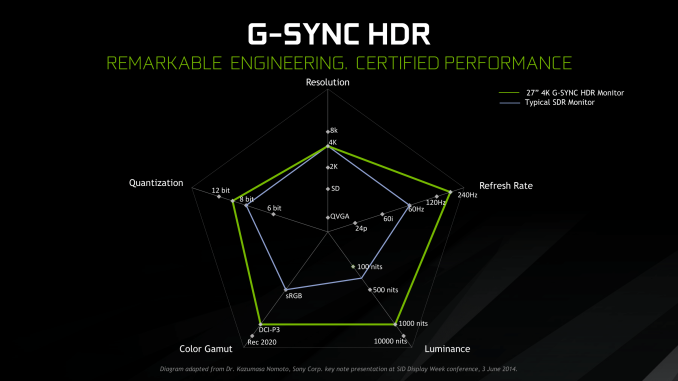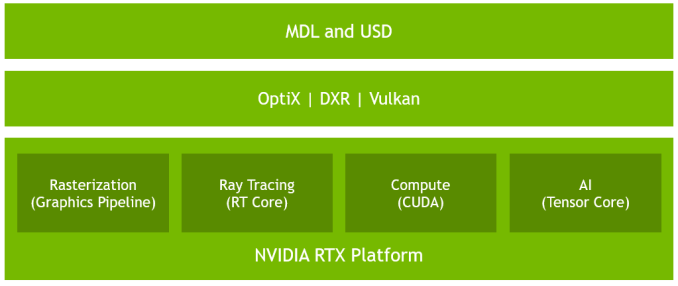The NVIDIA GeForce RTX 2080 Ti & RTX 2080 Founders Edition Review: Foundations For A Ray Traced Future
by Nate Oh on September 19, 2018 5:15 PM EST- Posted in
- GPUs
- Raytrace
- GeForce
- NVIDIA
- DirectX Raytracing
- Turing
- GeForce RTX
Meet The New Future of Gaming: Different Than The Old One
Up until last month, NVIDIA had been pushing a different, more conventional future for gaming and video cards, perhaps best exemplified by their recent launch of 27-in 4K G-Sync HDR monitors, courtesy of Asus and Acer. The specifications and display represented – and still represents – the aspired capabilities of PC gaming graphics: 4K resolution, 144 Hz refresh rate with G-Sync variable refresh, and high-quality HDR. The future was maxing out graphics settings on a game with high visual fidelity, enabling HDR, and rendering at 4K with triple-digit average framerate on a large screen. That target was not achievable by current performance, at least, certainly not by single-GPU cards. In the past, multi-GPU configurations were a stronger option provided that stuttering was not an issue, but recent years have seen both AMD and NVIDIA take a step back from CrossFireX and SLI, respectively.
Particularly with HDR, NVIDIA expressed a qualitative rather than quantitative enhancement in the gaming experience. Faster framerates and higher resolutions were more known quantities, easily demoed and with more intuitive benefits – though in the past there was the perception of 30fps as cinematic, and currently 1080p still remains stubbornly popular – where higher resolution means more possibility for details, higher even framerates meant smoother gameplay and video. Variable refresh rate technology soon followed, resolving the screen-tearing/V-Sync input lag dilemma, though again it took time to catch on to where it is now – nigh mandatory for a higher-end gaming monitor.
For gaming displays, HDR was substantively different than adding graphical details or allowing smoother gameplay and playback, because it meant a new dimension of ‘more possible colors’ and ‘brighter whites and darker blacks’ to gaming. Because HDR capability required support from the entire graphical chain, as well as high-quality HDR monitor and content to fully take advantage, it was harder to showcase. Added to the other aspects of high-end gaming graphics and pending the further development of VR, this was the future on the horizon for GPUs.
But today NVIDIA is switching gears, going to the fundamental way computer graphics are modelled in games today. Of the more realistic rendering processes, light can be emulated as rays that emit from their respective sources, but computing even a subset of the number of rays and their interactions (reflection, refraction, etc.) in a bounded space is so intensive that real time rendering was impossible. But to get the performance needed to render in real time, rasterization essentially boils down 3D objects as 2D representations to simplify the computations, significantly faking the behavior of light.
It’s on real time ray tracing that NVIDIA is staking its claim with GeForce RTX and Turing’s RT Cores. Covered more in-depth in our architecture article, NVIDIA’s real time ray tracing implementation takes all the shortcuts it can get, incorporating select real time ray tracing effects with significant denoising but keeping rasterization for everything else. Unfortunately, this hybrid rendering isn’t orthogonal to the previous concepts. Now, the ultimate experience would be hybrid rendered 4K with HDR support at high, steady, and variable framerates, though GPUs didn’t have enough performance to get to that point under traditional rasterization.
There’s a still a performance cost incurred with real time ray tracing effects, except right now only NVIDIA and developers have a clear idea of what it is. What we can say is that utilizing real time ray tracing effects in games may require sacrificing some or all three of high resolution, ultra high framerates, and HDR. HDR is limited by game support more than anything else. But the first two have arguably minimum performance standards when it comes to modern high-end gaming on PC – anything under 1080p is completely unpalatable, and anything under 30fps or more realistically 45 to 60fps hurts the playability. Variable refresh rate can mitigate the latter and framedrops are temporary, but low resolution is forever.
Ultimately, the real time ray tracing support needs to be implemented by developers via a supporting API like DXR – and many have been working hard on doing so – but currently there is no public timeline of application support for real time ray tracing, Tensor Core accelerated AI features, and Turing advanced shading. The list of games with support for Turing features - collectively called the RTX platform - will be available and updated on NVIDIA's site.













337 Comments
View All Comments
PopinFRESH007 - Wednesday, September 19, 2018 - link
news flash: 2080 Ti is an enthusiast product.tamalero - Thursday, September 20, 2018 - link
news flash.. 2080TI is just part of a large part of a system. Unlike a flagship phone.. You cant game with only a 2080TI or a 2080. You need other parts.Your argument is retarded.
Be honest, you got cash in nvidia's stock? your family works for Nvidia?
PopinFRESH007 - Thursday, September 20, 2018 - link
what argument is that? no I don't have any nVidia stock and none of my family work for them. You sound envious of people who can afford to be early adopters.tamalero - Friday, September 21, 2018 - link
You're defending the almost 50% price hike with a "is an enthusiast product".Now that is a dumb excuse.
Nothing to do with being envious. A fool and his money are soon departed. So if you want to buy it.
Go ahead!.
For the majority of us its not worth to buy something which its "flagship" features arent even working or available for probably months to come, has only 30% average performance increase, for almost double the price..
cmdrdredd - Wednesday, September 19, 2018 - link
I don't know anyone who has every paid for their phone outright. Everyone is on a lease/upgrade/Iphone forever plan.bji - Wednesday, September 19, 2018 - link
So you think that means they haven't paid full price for their phone? Or are you saying you don't understand how to buy a video card on a similar payment plan (hint -- it's called a credit card)?People have absolutely no sense of logic or really intelligence at all when it comes to evaluating technology prices. NONE. This forum, and pretty much every internet forum where predominantly inexperienced kids who have no clue how actual money works post (which is apparently all of them), is all the proof you need of that.
PopinFRESH007 - Wednesday, September 19, 2018 - link
^^ This, 100% this. People who think that changing the structure of payment somehow magically changes the price of something (other than increasing it due to TVM) are amazingly ignorant.Nagorak - Thursday, September 20, 2018 - link
It doesn't change the price, however it certainly hides the price. A lot of people would not buy their expensive phone if it meant coughing up $800 all at once.Nagorak - Thursday, September 20, 2018 - link
Not a good example. A credit card probably has 20% per year interest rate. A phone contact usually bundles in the monthly payment on the phone at low or no interest rate.Qasar - Thursday, September 20, 2018 - link
the carriers here ( canada ) have been considering dropping the " subsidized phone " thing for a few years now.. IF they do.. i wonder how many people would NOT get a new phone every year.... specifically those get " have to " get the new iphone every year... i dont know any one that would pay that much for a phone each year, if they had to buy it outright from their own pocket....